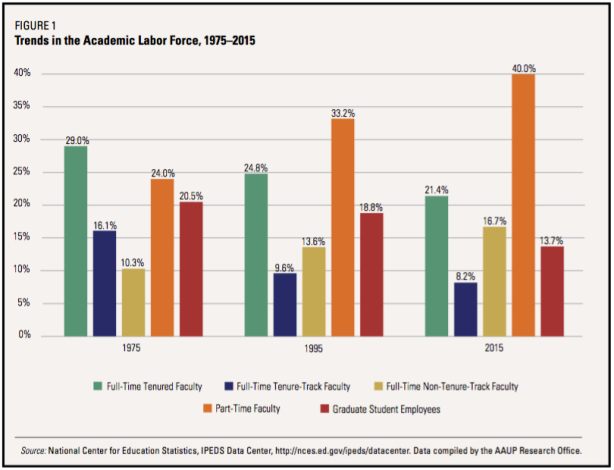From David Ruccio As we know, the share of part-time faculty in U.S. higher education has increased dramatically over the past four decades. According to the latest report from the American Association of University Professors (pdf), Part-time faculty today comprise approximately 40 percent of the academic labor force, a slightly larger share than tenured and tenure-track faculty combined. While the category of part-time faculty includes professors temporarily teaching on a percentage basis—professors on phased retirement who teach one or two courses at a reduced rate, new assistant professors who are teaching part-time while finishing a dissertation, and others—the vast majority (91 percent) teach on a per-section basis. The AAUP estimates that, in 2016–17, part-time faculty members teaching on a per-section basis earned a total of ,066, on average, from a single institution. Moreover, Most institutions avoid providing benefits to part-time faculty by prohibiting them from teaching more than two or three courses in a semester. The average pay from a single institution for part-time faculty teaching on a per-section basis is well below the federal poverty line of ,240 for a family of two.
Topics:
David F. Ruccio considers the following as important: Uncategorized
This could be interesting, too:
tom writes The Ukraine war and Europe’s deepening march of folly
Stavros Mavroudeas writes CfP of Marxist Macroeconomic Modelling workgroup – 18th WAPE Forum, Istanbul August 6-8, 2025
Lars Pålsson Syll writes The pretence-of-knowledge syndrome
Dean Baker writes Crypto and Donald Trump’s strategic baseball card reserve
from David Ruccio
As we know, the share of part-time faculty in U.S. higher education has increased dramatically over the past four decades.
According to the latest report from the American Association of University Professors (pdf),
Part-time faculty today comprise approximately 40 percent of the academic labor force, a slightly larger share than tenured and tenure-track faculty combined.
While the category of part-time faculty includes professors temporarily teaching on a percentage basis—professors on phased retirement who teach one or two courses at a reduced rate, new assistant professors who are teaching part-time while finishing a dissertation, and others—the vast majority (91 percent) teach on a per-section basis.
The AAUP estimates that, in 2016–17, part-time faculty members teaching on a per-section basis earned a total of $7,066, on average, from a single institution. Moreover,
Most institutions avoid providing benefits to part-time faculty by prohibiting them from teaching more than two or three courses in a semester. The average pay from a single institution for part-time faculty teaching on a per-section basis is well below the federal poverty line of $16,240 for a family of two. Even if we assume that a part-time faculty member teaches three courses at one institution and three at another, the earnings from those courses would still likely place him or her near the poverty line.
Part-time faculty are the working poor who today walk the supposedly hallowed halls of the academy.

